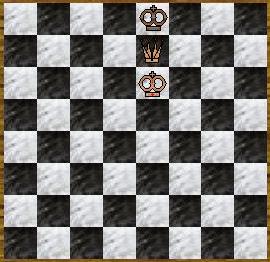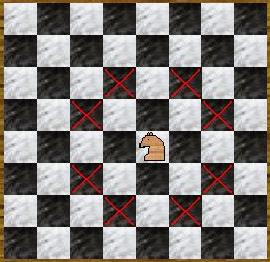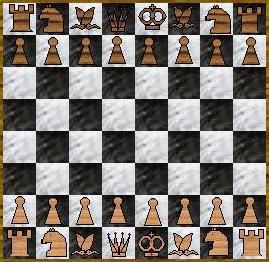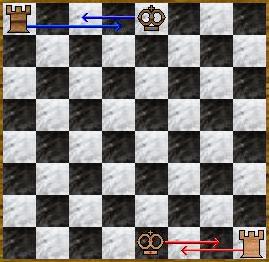| Idiot-proof chess help | |
Affiliates Navigation |
How to play chess: The Idiot-proof Guide In chess, the object is to checkmate the opponent's King, that is to attack it in such a way that it cannot move without being captured:  This is a picture-perfect example of a checkmate. The Black King will be captured wherever it moves, or if it stays where it is. But, how do the pieces move?  The pawn moves 1 space forwards when moving passively (that is, not capturing), but, when it first move, it can decide to move two squares forwards instead of one. To capture, and ONLY to capture, it moves 1 space diagonally forwards. I hear you asking, "What happens to a pawn when it reaches the end of the board and can't move?" Well, it can 'promote' to a piece of its choice other than a King. Usually, a pawn will promote to a Queen.  The Rook, or Castle, moves any number of spaces forwards, backwards or sideways.  The Knight moves 2 squares like a Rook, then turns 90° and moves 1 space like a Rook:  It is the only piece that can jump over other pieces, which is pretty useful, especially at the start of the game!  The Bishop moves any number of squares diagonally.  The Queen moves any number of spaces in any direction.  The King moves 1 space in any direction. Starting position The starting position is as follows:  Note that: 1) There is a white square in the bottom-right-hand corner of the board (Something which many beginners get wrong). 2) The Queens start on their own colour, on the d-file. 3) The Kings start on the e-file (Another of the most common mistakes made by beginners is to put the King and Queen the wrong way round). Capturing, Check, Checkmate and Stalemate A piece 'Captures' another piece by moving onto its square. The captured piece is then removed from the board; for pretty obvious reasons, you can only capture opponent's pieces (although there will be times when you wish you could - there have been when I've been playing!). When the King is attacked (i.e. captured on the next move), that King is said to be in check. You can solve this in one of the following ways:  Capturing the attacking piece. Capturing the attacking piece. Blocking the attacking piece by putting one of your own pieces between your King and the attacking piece (You can't to this to a Knight - it'll just jump over it!). Blocking the attacking piece by putting one of your own pieces between your King and the attacking piece (You can't to this to a Knight - it'll just jump over it!). Moving the King to a safer square. Moving the King to a safer square.Usually, the checking player will announce: "Check," when checking their opponents King (Likewise, they'll announce: "Checkmate," when checkmating). If none of these can get them out of check, it is checkmate, and the checking player has won! Sometimes, you'll get into a position when one player can't move, because all of their pieces are blocked and thus can't move anywhere, and their King can't move without going into check. This situation is called stalemate, and is a draw. En passant and castling These are two rules that can be a bit confusing to beginners, especially en passant, but let's see how we do: Castling is a move in which a Rook jumps over the King. In such a move, the King is moved two spaces sideways, and the Rook closest to him jumps over him to the next square:  You can only castle if: 1) None of the squares involved are blocked or attacked. 2) Neither piece is threatened with capture. 3) It is the first move of the game for both the King and the Rook. 4) The King and the Rook must both be on the same rank (this is so that you can't promote a pawn to a Rook and castle with that!). One basic opening principle followed by many players is to castle early in the game, removing their King from the center and putting a Rook in the center. En passant is a French term meaning 'in passing'. In such a move, if a Pawn moves forwards two squares so that it's horizontally adjacent to an enemy Pawn, that Pawn can capture it:  Note that en passant can only be played immediately after the Pawn has moved two squares forwards. Other kinds of draws Threefold repetition occurs when the exact same position occurs 3 times in a row. Perpetual check is like threefold repetition, except a King is repeatedly checked. 50 moves rule: The game is drawn after 50 moves without a capture or a Pawn move. Mutually agreed draw: The players can agree a draw at any point in the game. Finally, if you liked this guide, please visit some of the other sections on my site! If you think something's missing, spot a typo, or anything in here is incorrect, then please e-mail me or tell me on my forum. © 2004-2007 Chess Resources King. All rights reserved. |